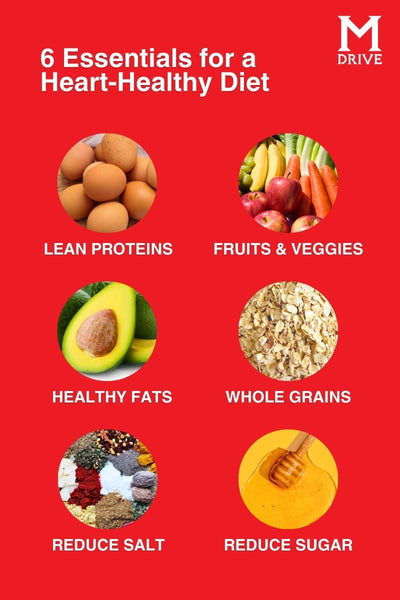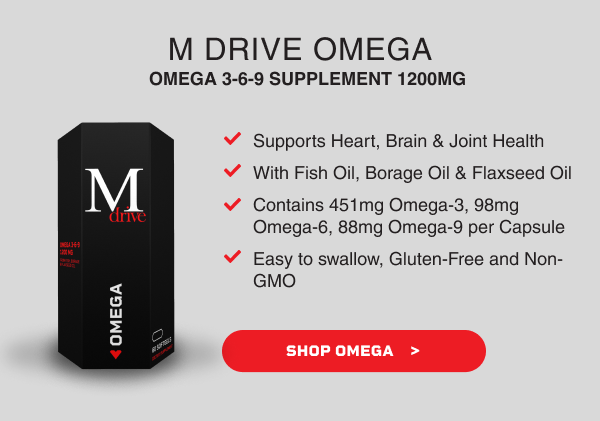![Crafting a Heart-Healthy Diet [That Still Lets You Eat Red Meat]](http://www.mdriveformen.com/cdn/shop/articles/Blog_Hero_Images_1.jpg?crop=center&height=8&v=1709223705&width=20)
Crafting a Heart-Healthy Diet [That Still Lets You Eat Red Meat]
Welcome to our guide on crafting a heart-healthy diet for optimal cardiovascular health. In today's fast-paced world, taking care of our hearts is more important than ever. This article will explore the essentials of a healthy diet for the heart, offering practical tips and insights to help you make informed choices. From nutritious superfoods to smart meal planning strategies, we'll cover everything you need to know to nourish your body and support your cardiovascular well-being. So, let's dive in and discover how small changes in your diet can lead to significant benefits for your heart health.
| Table of Contents |
Why You Should Eat Heart-Healthy
According to the CDC, heart disease remains the leading cause of death for men in many demographics, including those above 30, African Americans, Hispanics, Alaska natives, and Whites. And for Asian Americans, it is the second biggest cause of death after cancer. This sad reality underscores the importance of maintaining a healthy heart for a longer and happier life.
In our contemporary era, our diets are filled with too much sugar, unhealthy fats, and an abundance of high-calorie and low-nutrient meals, which pose a significant danger to the health of our cardiovascular system. The ease of processed food and the prevalence of fast foods contribute to the cases soaring faster than ever before; thus, dietary caution is necessary.
When you combine a healthy diet with a healthy lifestyle, it has the potential to reduce heart and cardiovascular disease risk by 70 - 80 % and improve blood pressure.
The six essential components of a heart-healthy diet
1. Vegetables & Fruits
Most vegetables and fruits are rich in Vitamin C, minerals, and dietary fiber and are low in calories. These nutrients work together as antioxidants, which reduce or prevent atherosclerosis, the thickening of the arteries caused by the buildup of plaques from fatty substances and cholesterol in the arteries.
According to the Harvard Medical School, eating five servings[ 2 ½ cups] of fruits and vegetables daily can lower the risk of heart attack and stroke. But if you increase your intake to 10 servings a day, you may reduce the risk of cardiovascular disease by 28% and premature death by 31%.
Adding fruits and vegetables to your diet is easy; wash, cut, and store them in the fridge for easy snacking. Put your fresh vegetables and fruits in a bowl on your kitchen counter so you will remember to eat.
For fruits, go for apples, oranges, pears, and citrus. They offer the best results. The best vegetable options are beets, winter squash, leafy greens, cruciferous vegetables, and sweet potatoes.
2. Whole Grains
Whole grains can act as a defense against heart disease, and a study says that eating fiber can reduce cholesterol and plaque buildup. This makes them a healthy diet for heart as they contain all the grains, including the bran, germ, and endosperm.
Aside from reducing cholesterol and plaque buildup, whole grains have photochemical compounds with anti-inflammatory properties that prevent chronic diseases.
Oats are the best whole grains you can add to your meal. They are affordable, less inflammatory, and have beta-glucan, which combines with water to remove bad cholesterol from your bloodstream. Barley, sorghum, and brown rice are good alternatives; they promote heart health. We recommend whole grains for your heart diet because refined grains have little to no dietary fiber.
3. Low-Fat Proteins
Regarding your protein and fat intake, it's good to eat from different sources. However, you must be selective because you can get more protein than your body needs when you eat meat high in saturated fats, which can elevate the low-density lipoprotein (LDL] and cause heart disease.
Opt for low-fat protein sources like lean meat, fish, eggs, and legumes. They are the best sources of protein. Go for skim milk rather than whole milk or skinless chicken breasts rather than fried chicken patties, or substitute plant protein for animal proteins, which will help increase fiber intake.
Fishes like mackerel and salmon are rich in omega-3 fatty acids, which reduce triglycerides [ blood fats]. Rich protein sources include walnuts, soybeans, flaxseed, almonds, prawns, and oysters.
4. Healthy Fats over Saturated Fat
You shouldn't get rid of fatty foods completely because some fats play crucial roles in keeping your heart healthy. There are four types of fats
-
Monounsaturated
-
Polyunsaturated
-
Saturated
-
Trans
When adding fats to your diet, choose fats that reduce cholesterol, lower cardiovascular risks, and make your food flavorful.
The mono and polyunsaturated fats are the good fats and foods that contain them include nuts and seeds, olive oils, avocados and oils, salmon, mackerel, and sardine.
Saturated and trans fats are unhealthy and should be avoided. Their food options include coconut oil, hydrogenated plants like the copha, partially hydrogenated oils or wholly hydrogenated oils, processed food such as biscuits, cakes, pastries, salami, bacon, and sausage, and animal fats such as butter, visible fats on the skin and takeaway food like hamburger.
Trans fats are the worst; they have the highest mortality rate. Unsaturated fats increase the bad cholesterol, which can lead to coronary heart disease. Opt for cooking oils from plants, seeds, avocados, almonds and peanuts. Your food should contain omega-3 and omega-6.
5. Reduce Salt Intake
We get sodium from table salt, made from sodium [ 40%] and chloride [ 60%]. However, most of our sodium comes in packaged or processed food. Sodium is used for flavoring, preserving, and reducing microbial activities. The Dietary Guidelines for Americans recommends we eat 2300 mg of sodium daily. However, we consume 3400mg.
Excessive sodium intake is linked to water retention, increasing blood pressure in your blood vessels. Reducing salt in your food is one of the best ways to lower your blood pressure. Eat fresh foods, cook your soup, and avoid packaged foods.
But if you can't do without packaged processed foods, look for food with little or no addition of sodium. But, you must be careful about foods claiming no sodium salt; many are seasoned with sea salt.
The sea salt is the same as regular salt. To reduce sodium intake, you can use salt alternatives like garlic, onion, nutritional yeast, herbs & spices, vinegar, and paprika when cooking.
6. Reduce Added Sugar
Sugars are present in carbohydrates, whole foods, fruits, and vegetables. These sugars present in the foods are natural; they are healthy, and it's okay to eat them. For men, especially those who are above 30, eating added sugar is ill-advised and could be detrimental to your health. Added sugar is made industrially and is used for preservation and flavoring. They are present in fruit drinks, candies, cookies, soft drinks, yogurt, bread, and cured meats.
They are linked to weight gain, type 2 diabetes, dental problems, and fatty liver disease. American Health says the ideal amount of added sugar men should consume is less than 150 calories [ 9 teaspoons]; for women, it's 100 calories [ 6 teaspoons]. The best way to reduce added sugar in your diet is to reduce the amount of sugar you add to your coffee and tea.
Also, when buying processed food, look at ingredients to see if sugar is listed. Most times, you might not see the word "sugar" outright; it uses other names, including brown sugar, fruit juice concentrate, honey, invert sugar, molasses, corn syrup, malt sugar,high-fructose corn syrup, and sugar molecules ending in "ose" (glucose, fructose, lactose, maltose, sucrose).

Sample Meal Plan for Heart Health
If you find yourself struggling to plan a heart-healthy diet, it's essential to focus on incorporating plenty of fruits, vegetables, and whole grains while limiting your intake of fat, sodium, and added sugars. Below is a three-day menu plan designed to provide you with inspiration and guidance for planning nutritious meals:
Day 1:
Breakfast:
-
1 cup of nonfat plain Greek yogurt
-
¾ cup of fresh blueberries
-
1 ½ tablespoons of slivered almonds
-
2 teaspoons of honey
Lunch:
-
1 serving of Tuna, White Bean & Dill Salad
-
1 orange
Dinner:
-
1 serving of Skillet Lemon Chicken & Potatoes with Kale
Day 2:
Breakfast:
-
¾ cup of bran cereal
-
¾ cup of fat-free milk
-
½ cup of fresh blueberries
Lunch:
-
1 serving of Grilled chicken salad with mixed greens, cherry tomatoes, avocado, cucumbers, and a vinaigrette dressing.
Dinner:
-
1 serving of Toaster-Oven Tostadas
Day 3:
Breakfast:
-
1 cup of cooked oatmeal sprinkled with one tablespoon of chopped walnuts and 1 teaspoon of cinnamon
Lunch:
-
1 serving of Spinach & Strawberry Meal-Prep Salad
Dinner:
-
1 1/4 cups of Cauliflower Chicken Fried "Rice”
It's crucial to be mindful of portion sizes while following your heart-healthy diet. Even if you're consuming nutritious foods, overeating can lead to consuming more calories than your body needs. To manage portion sizes, consider using smaller plates or bowls, and pay attention to serving sizes as indicated by measuring cups, ounces, or pieces.
Snacks and desserts
While adhering to your heart-healthy diet is important, it's also okay to indulge in occasional treats. Enjoying a small serving of your favorite treat once in a while can be part of a balanced approach to eating. However, it's essential not to make indulgent foods a habit and to prioritize nutrient-dense options in your daily diet.
Ideal heart-healthy snacks include a combination of fruits, vegetables, nuts, seeds, whole grains, and some fat free or low-fat dairy products. Overall, opting for nutrient-dense snacks that are low in added sugars, unhealthy fats, and sodium can support cardiovascular wellness and contribute to long-term heart health. Some ideas are:
-
Fresh fruits such as berries, apples, and oranges. Bake and add cinnamon or honey for a warm dessert.
-
Vegetables like carrots, cucumbers, and bell peppers
-
Nuts and seeds, such as almonds, walnuts, and chia seeds
-
Whole grains like whole grain crackers, air-popped popcorn, or whole grain bread with hummus or avocado
-
Low-fat dairy options like Greek yogurt or cottage cheese.
-
Dark chocolate with a high cocoa content (70% or higher)
Red meat and heart health

Sure, you're focusing on your heart health. But do you really have to give up bacon?!
While it's not necessary to completely eliminate red meat from a heart-healthy diet, it's important to consume it in moderation and choose lean cuts.
Red meat, particularly fatty cuts like beef or pork, can be high in saturated fats, which may contribute to elevated cholesterol levels and increased risk of heart disease when consumed in excess. However, lean cuts of red meat, such as sirloin or tenderloin, can still be included as part of a balanced diet. It's also advisable to trim visible fat and opt for cooking methods that don't add extra fat, such as grilling, baking, or broiling.
Heart-healthy meals with red meat
-
Grilled Sirloin Steak with Roasted Vegetables: Choose a lean cut of sirloin steak, trim any visible fat, and marinate it with herbs and spices. Grill the steak to perfection and serve it with a colorful assortment of roasted vegetables such as bell peppers, zucchini, and carrots. Drizzle with a touch of olive oil and sprinkle with fresh herbs for added flavor.
-
Beef Stir-Fry with Brown Rice: Slice lean beef (such as sirloin or flank steak) thinly and stir-fry it with an array of colorful vegetables like broccoli, bell peppers, and snap peas. Use a minimal amount of heart-healthy oil, such as olive or avocado oil, and season with garlic, ginger, and low-sodium soy sauce. Serve the stir-fry over cooked brown rice for a nutritious and satisfying meal.
-
Beef and Vegetable Kebabs: Thread lean beef cubes onto skewers along with colorful vegetables such as cherry tomatoes, mushrooms, onions, and zucchini. Grill the kebabs until the beef is cooked to your desired level of doneness and the vegetables are tender. Serve with a side of whole grain couscous or quinoa for a balanced meal.
-
Lean Beef Chili: Make a hearty chili using lean ground beef, kidney beans, tomatoes, onions, bell peppers, and spices. Opt for a lean ground beef with a lower fat percentage, and drain off any excess fat after browning. Serve the chili with a dollop of Greek yogurt or avocado slices instead of sour cream for added creaminess.
Red meat Substitutes
Red meat substitutes offer flavorful and nutritious alternatives for various meat-based dishes, including meatballs, bacon, and more. Turkey meatballs provide a leaner option compared to traditional beef meatballs while still offering a savory taste and juicy texture. Similarly, turkey bacon offers a smoky and crispy alternative to pork bacon, with lower fat content and fewer calories. Chicken sausage can serve as a tasty substitute for pork sausage in breakfast dishes, pasta sauces, and casseroles, providing a lighter option. There are also many plant-based options available that mimic the taste, texture, and mouthfeel of red meat, including Beyond Meat, Impossible Foods, jackfruit, and mushroom-based meat alternatives.
Overall, moderation and mindful selection of lean cuts of red meat can be compatible with a heart-healthy eating pattern.
Supplements to support a healthy heart
What matters the most for your cardiovascular health is your diet and lifestyle. But no matter how amazing your fitness and nutrition is, they might not give you everything you need.
Supplements can augment these deficiencies, keep your heart beating right, and ensure your blood flows well. Research says that if the right supplements are used, billions of dollars can be saved to prevent heart-related hospitalization in the US.
When choosing a supplement, you should know why you want to use it and go for supplements that a third party has tested. Discuss with your doctor whether supplements suit you if you have any heart conditions. If you want to use a supplement for your heart health, M Drive Omega is a great option.
This supplement is a blend of omega-3, omega-6, and omega-9, derived from fish oil, borage oil, and flaxseed oil. It supports your heart, brain, and joint health.
Also, M Drive omega undergoes rigorous testing to ensure it gives optimum results. The Mdrive Omega is affordable and is the best supplement you can use with your heart health diet.

Final thoughts
Given that 1 out of every 5 men dies from heart disease, it's wise to monitor your cholesterol levels constantly. However, if you can incorporate these tips we've discussed, you will find that living healthier is possible.
What will you do better?
Will you prioritize eating vegetables and fruits or reduce dining in restaurants? Will it be to get a supplement or maintain doing exercises?
Whatever your choice, remember that your heart holds the key to your longevity.
Frequently Asked Questions
What are the essential components of a heart-healthy diet?
The six essential components include:
-
Vegetables & Fruits
-
Whole Grains
-
Low-Fat Proteins
-
Healthy Fat over Saturated Fat
-
Reduced Salt Intake
-
Reduced Added Sugar
What types of fats should I consume for a heart-healthy diet?
Healthy fats, such as monounsaturated and polyunsaturated fats found in nuts, seeds, olive oil, avocados, and fatty fish like salmon, are recommended. Saturated and trans fats, found in processed foods and animal products, should be limited or avoided.
Can supplements help support heart health?
While a healthy diet and lifestyle are crucial for heart health, supplements can help fill in nutritional gaps. Consult with your doctor before taking supplements, and choose those that have been third-party tested for quality and safety.
What is Mdrive Omega, and how can it benefit heart health?
Mdrive Omega is a supplement containing omega-3, omega-6, and omega-9 fatty acids derived from fish oil, borage oil, and flaxseed oil. It supports heart, brain, and joint health.
How can I incorporate healthier habits into my lifestyle for better heart health?
Incorporate outdoor activities like hiking and cycling, avoid smoking and excessive alcohol consumption, and prioritize regular exercise and stress management techniques for overall heart health.
What steps can I take to monitor and improve my heart health?
Monitor cholesterol levels regularly, prioritize a heart-healthy diet rich in fruits, vegetables, whole grains, and healthy fats, engage in regular physical activity, and consult with healthcare professionals for personalized advice and guidance.


